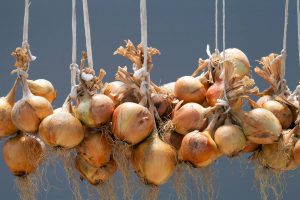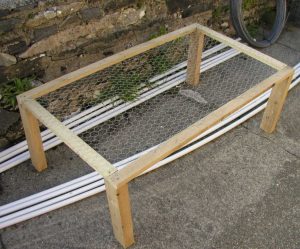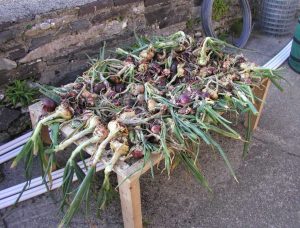You can pull an onion up at any point for immediate use but for onions to store well you need to be a little more subtle. As the season ends we want the onion to concentrate on the bulb and we don’t want that bulb too wet. So come August cease watering unless the weather is really hot and bone dry. Even then, only water lightly every few days.
The leaves will start to bend over of its own accord, which is the signal that harvest is near. You will read in old books about bending the leaves over at the neck. I’d suggest you not do it because it causes damage to the neck causing problems in storage or at least be very careful and just help rather than force the leaves over.
Once the leaves have gone over, gently lever under the bulbs with a fork to loosen most of the roots. Leave for a week and then lift the crop. Next we need to dry out the crop for storage. Storing partially dry onions is just asking for moulds and rot to spoil the crop.
Drying The Crop
The ideal is to place them on some sort of rack outdoors where air can flow all around them for a couple of weeks. I’ve constructed drying racks using scrap wood and chicken wire in less than an hour which are perfect for the job and will last years.
If the weather is really wet you need to provide some sort of cover over them to keep the rain off, the odd shower will not cause any harm though.
The problem here is that bad wet weather tends to be accompanied by wind and sheltering tents made of clear polythene are very light and blow away. In 2007 I tried drying onions in a greenhouse. One day it got really hot and, despite the vents being open on the greenhouse, the air filled with the smell of cooking onions. Needless to say, they were ruined and could not be kept.
Moving them indoors to a cool garage is ideal but the lack of wind won’t help them dry much. To get around this you can use a fan to blow air under and across the onions. Many fan heaters have a fan only setting and can do the job. The electricity used by a fan only is minimal
If you’ve any onions with thick necks, perhaps they’ve started to bolt, separate these out and put aside to use first as they won’t store for long and like a rotten apple spoils the barrel a rotten onion spoils the bunch.
If you’ve a lot of thick necks consider drying as a storage method. Prepare and slice the onions into rings and dry using a dehydrator, storing in airtight storage boxes for use in stews etc.
With the rest trim off any roots left on and tidy up the leaves. A pair of kitchen scissors is the ideal tool for this. You can now string the onions in the traditional style and hang in a cool, dry, dark and airy place but importantly frost free. If the temperature drops below freezing the onions will freeze and come the thaw the damaged cells, caused by the formation of ice crystals, will rot in short order.
Often people find stringing onions too complicated or time consuming. In that case trim the leaves to a couple on centimetres long. Small net bags or even a leg cut off from laddered tights can be used and the bags hung up so air can circulate.
If you’ve a purpose built food store, then you can store on slatted shelves. I’ve also come across the drying frame being used as a storage shelf.
Shallots should be split into individual bulbs, the leaves trimmed to a few centimetres and preferably stored in net bags.
How Long Will Onions & Shallots Store For
Properly dried and stored onions should last 8 to 10 months. After six months check more thoroughly each week and use any that are starting to go soft.
Shallots have an advantage over onions, possibly due to their smaller size, in that they store for longer. 12 months is not unusual and we’ve had shallots perfectly good to use after 18 months.
Information on Growing Onions
How to Grow Onions – GuideProperly
- Harvesting and Storing Onions & Shallots
- How to Grow Onions from Seed – Allium Cepa
- How to Grow Onions from Sets – Allium Cepa
- Onion Pests, Diseases & Problems
Growing Onions for Show
- Growing Onions for Show – Selecting & Propagating Onions
- Growing Onions for Show – 250 gram Exhibition Onions
- Growing Onions for Show – Starting Large Onions from Seed
- Growing Onions for Show – Cultivating Exhibition Onions






